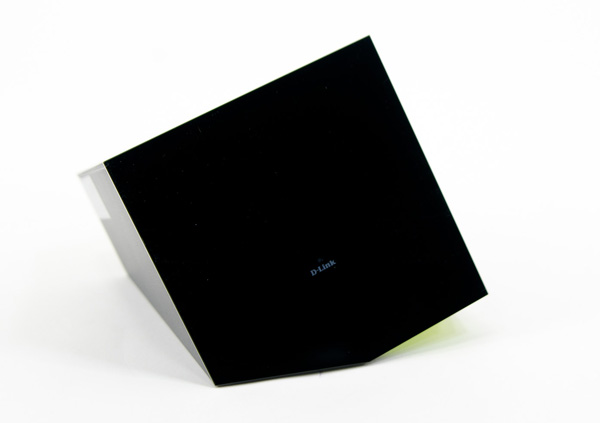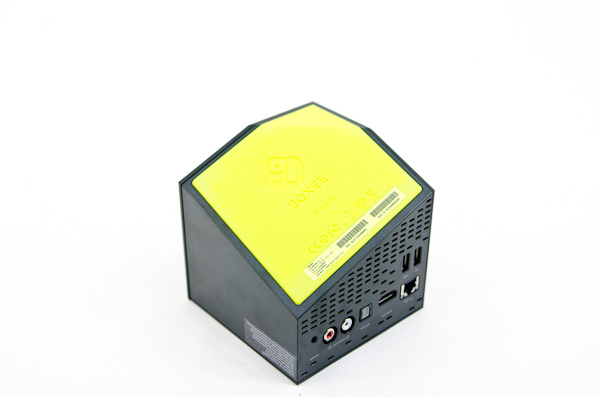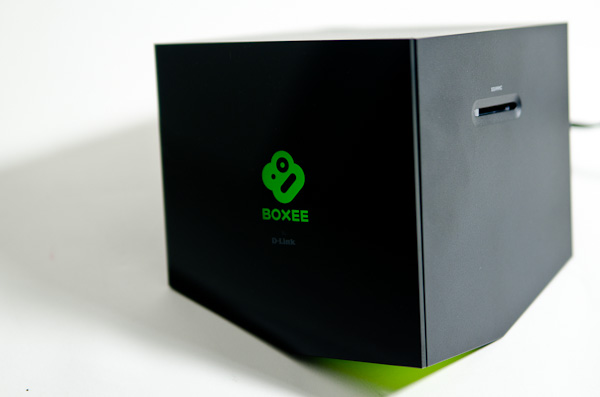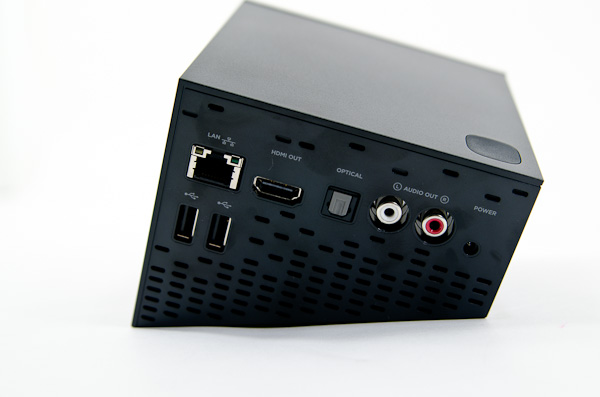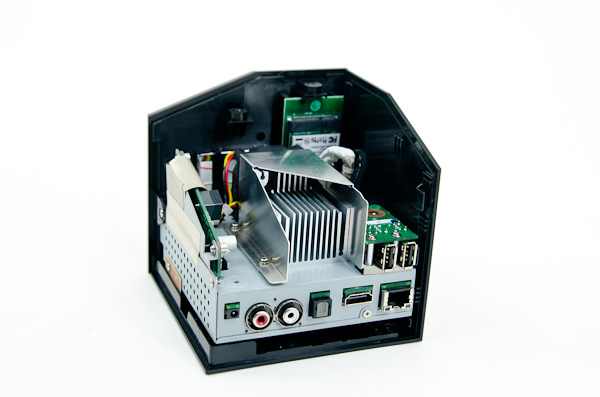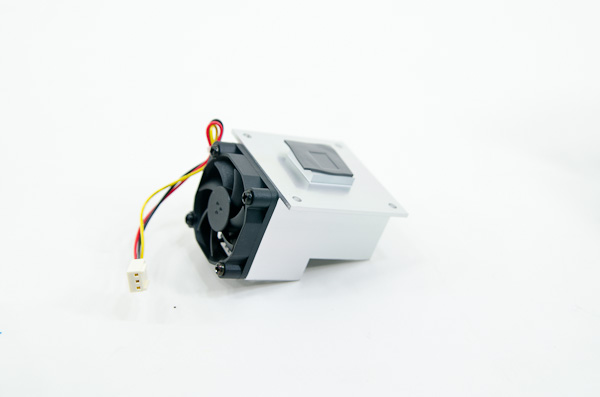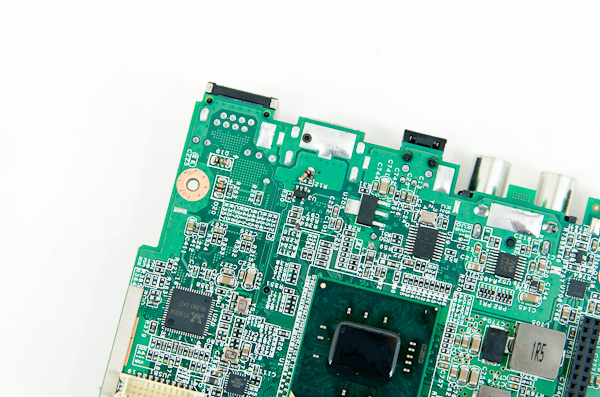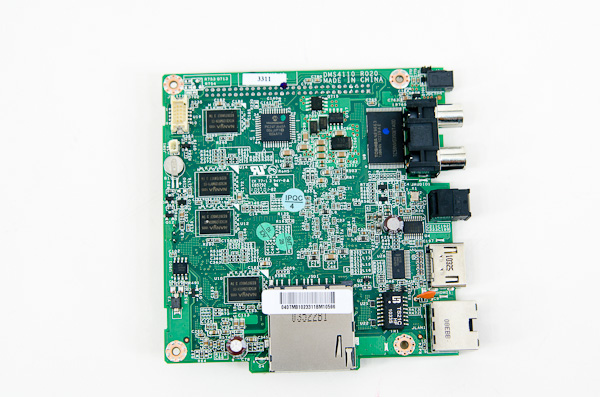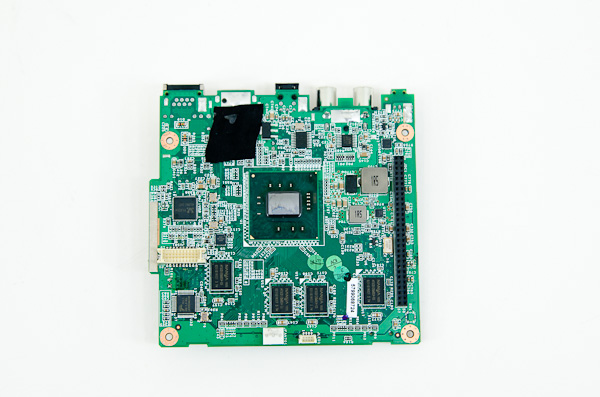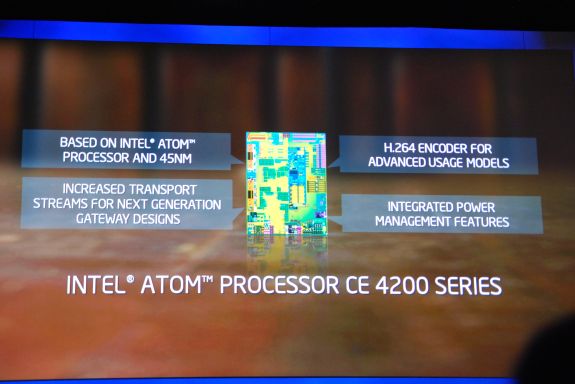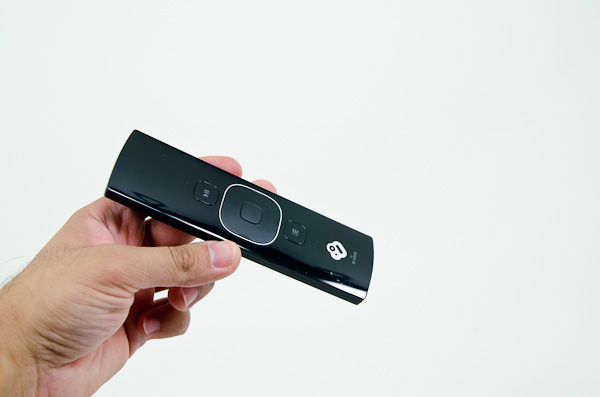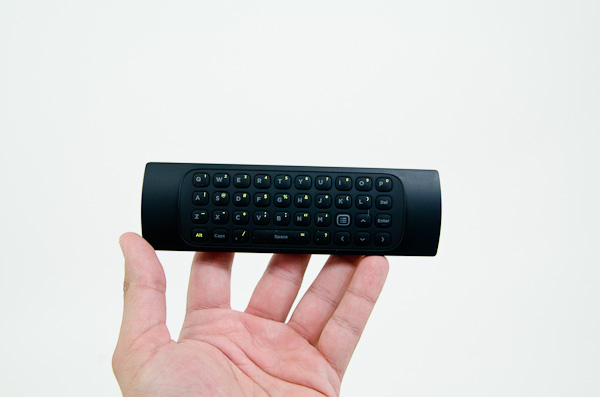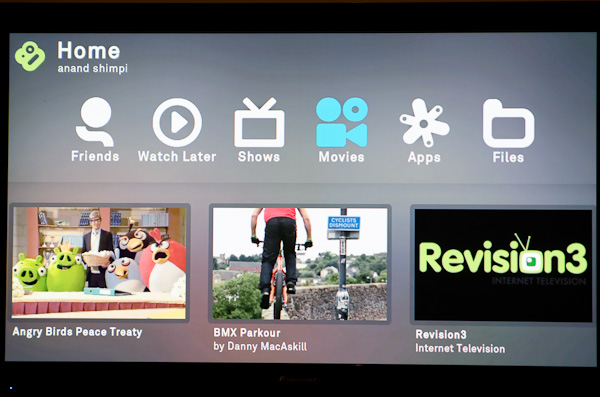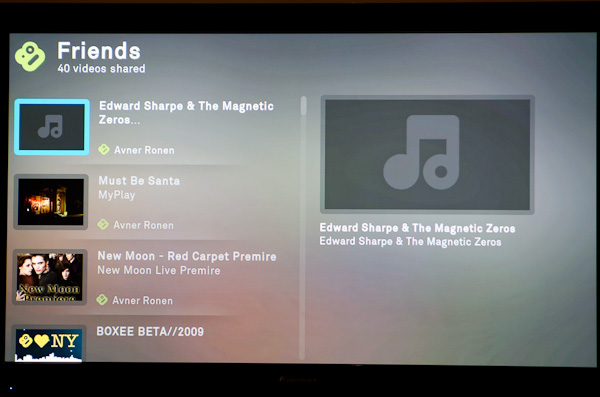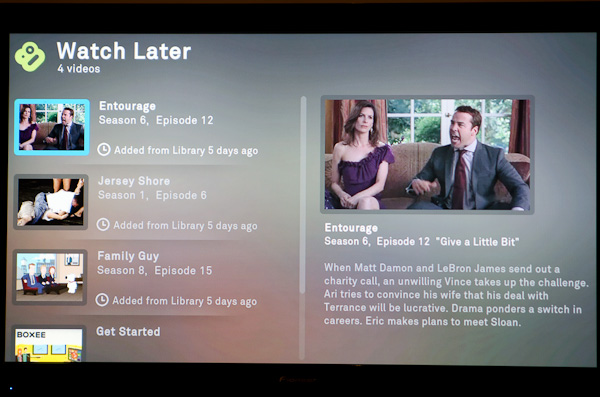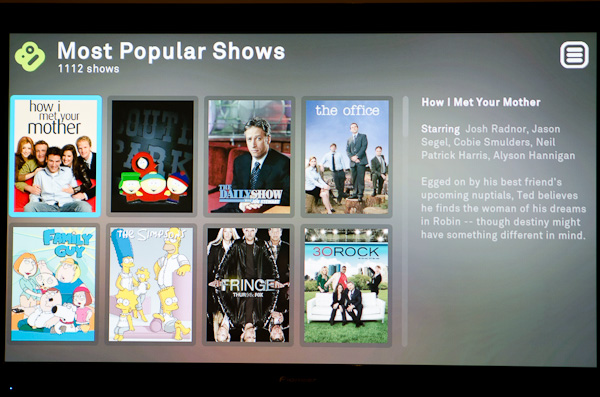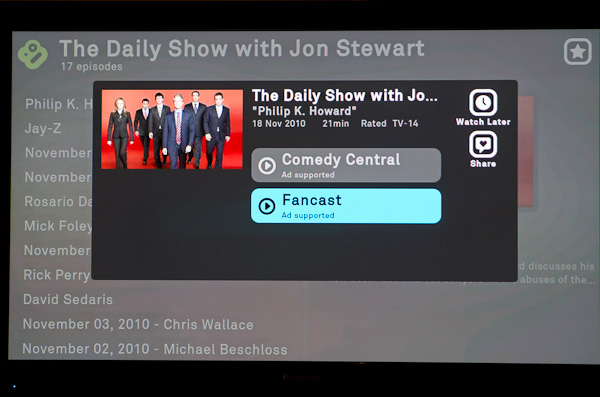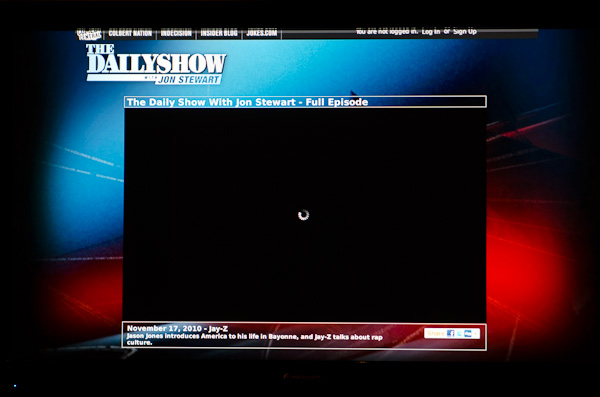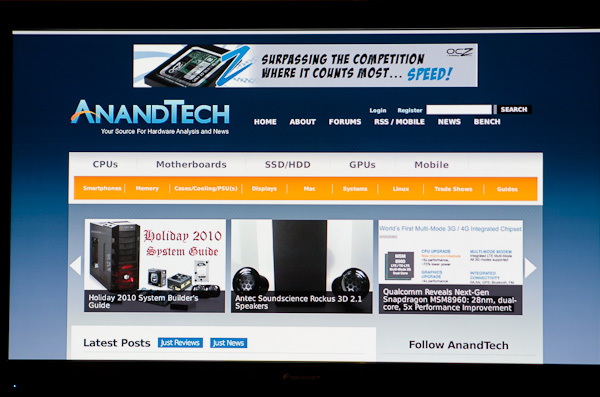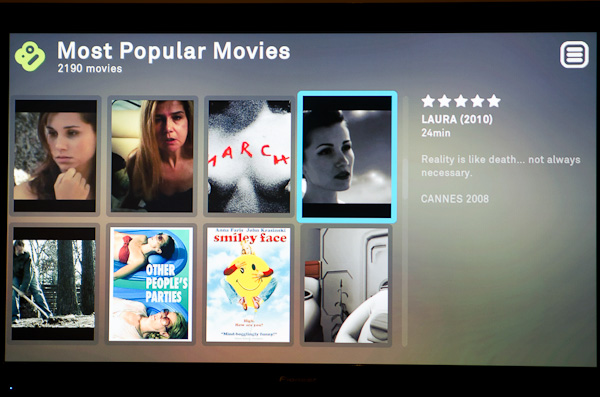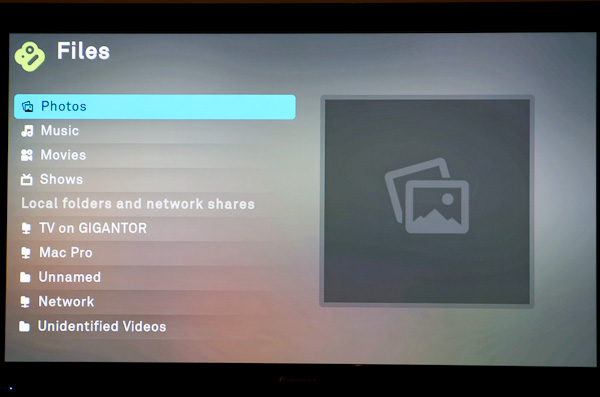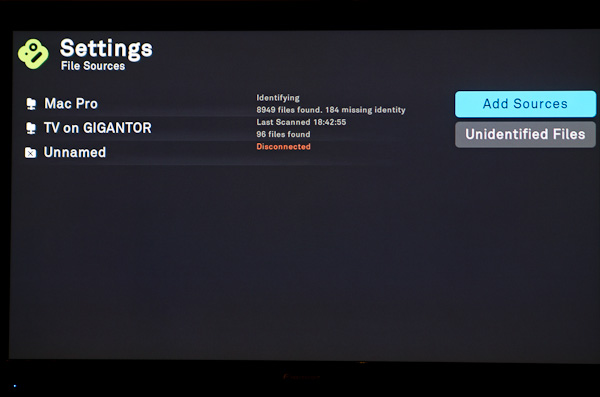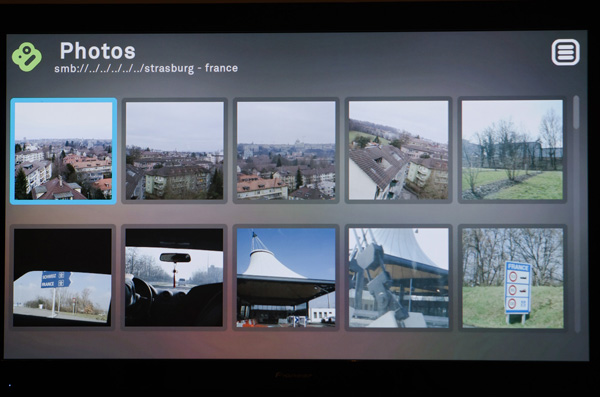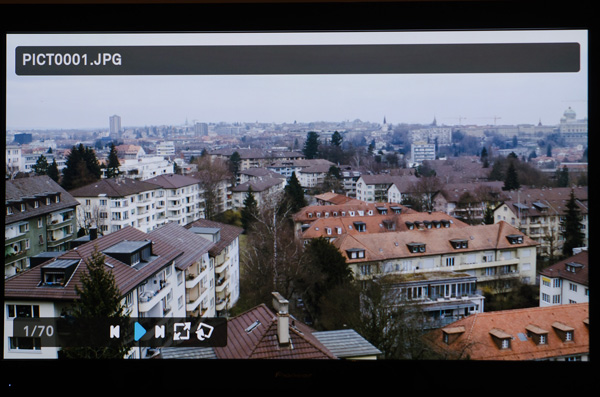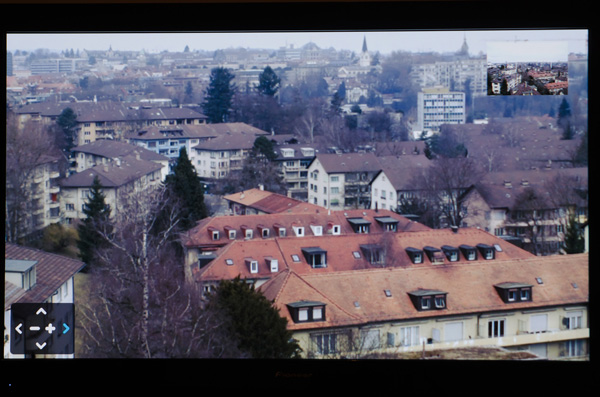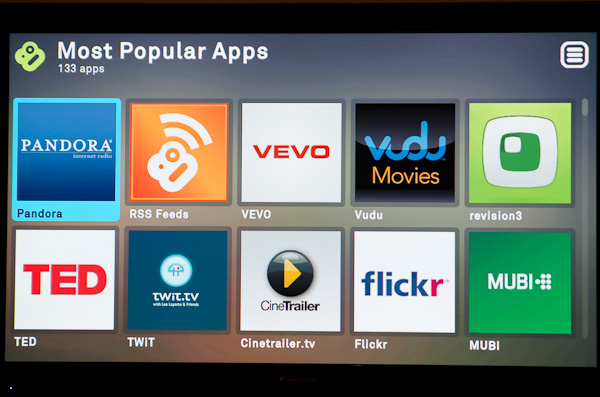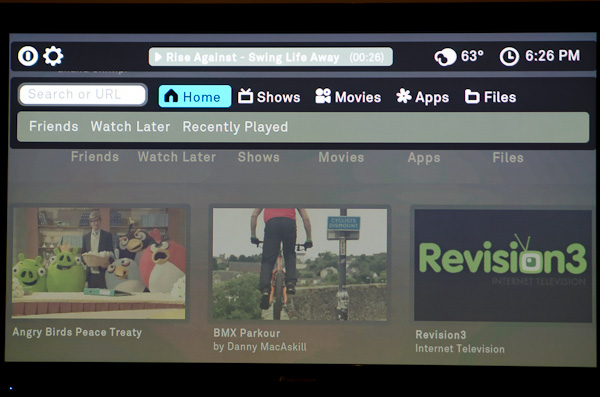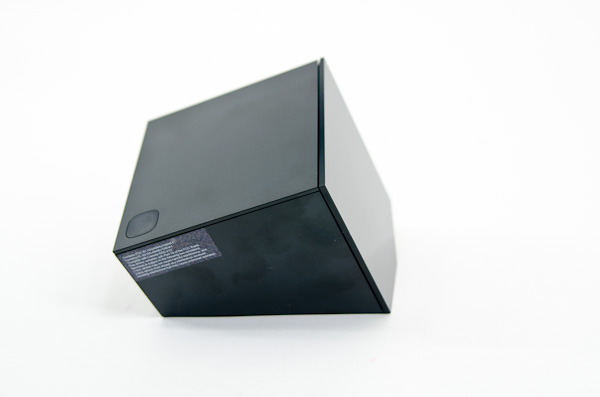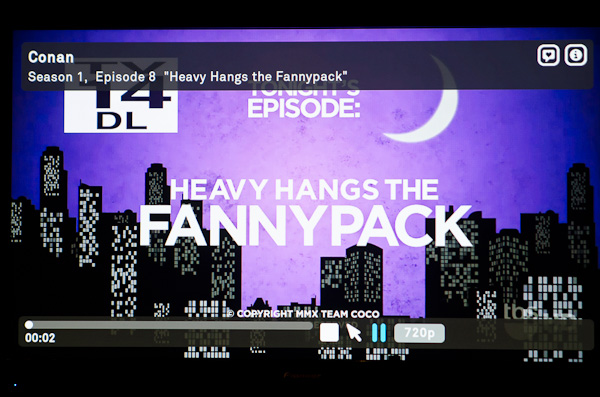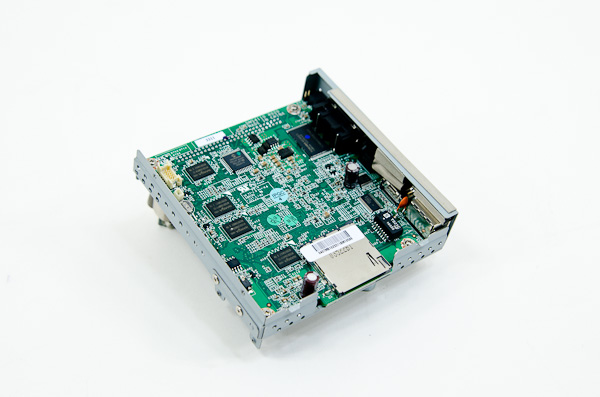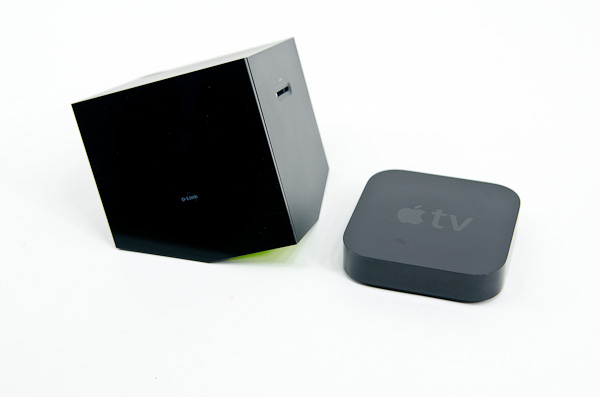
Original Link: https://www.anandtech.com/show/4029/the-boxee-box-review
The Boxee Box Review
by Anand Lal Shimpi & Ganesh T S on November 23, 2010 5:42 PM EST- Posted in
- Media Streamer
- HTPC
- Gadgets
- Boxee Box
Content aggregation has been instrumental in the development of the web. In the early days of the web, destinations held all the power. If you wanted news or reviews you went to news and review sites, consuming the content they had to offer at each individual website. Email newsletters were the first to really change the manner in which content was consumed online. Instead of visiting a website to read the latest it had to offer, you got an email in your inbox with either complete content or enough of a teaser for you to decide whether or not you were interested in it.
These days we have many more ways to get access to written content on the web than a simple newsletter. There’s RSS, Twitter and Instapaper among others. It generally works well. RSS didn’t stop users from visiting websites, neither did Twitter and Instapaper hasn’t spelled the end of the front page either. If anything all of these technologies have helped make consuming content online easier. While the front page of any website today isn’t quite as big of an example of prime real estate as it was 10 years ago, it’s still quite valuable.
I mention this history for one important reason: we haven’t seen the same progress with aggregating and distributing television content on the web. These days you can find a lot of cable TV content on the web, usually posted the day after the shows air live on cable TV. All of the major networks support it. Visit Fox.com, NBC.com or CBS.com and you’ll be greeted with ways to watch all of the shows they air via the web. The content is all out there, and it wouldn’t be too difficult to aggregate it all into one cable-TV-like interface. In theory, with what’s posted online already, you could pull the plug on cable and just rely on video over the web without missing much. It’s just not quite as easy as a cable subscription with a DVR. This is where Boxee comes in.
Front and center at the official Boxee website is the intent:
“A lot of your favorite shows and movies are already available on the Internet.
Boxee is a device that finds them and puts them on your TV. It’s easy to use and even better, there’s no monthly fee.“
I couldn’t have said it better myself. Boxee’s software was branched off of the Xbox Media Center project and now includes a lot of Boxee’s own code on top of the XBMC base. It’s freeware and available for Linux, OS X and Windows. No strings attached.
Just as people used ION to build XBMC boxes, Boxee encourages users to do the same and build their own Boxee boxes. And if you don’t want to bother building your own, Boxee teamed up with D-Link to build the Boxee Box by D-Link:
Boxee and D-Link's joint work on the Boxee Box became public knowledge around a year back. The streamer itself made a public appearance at the 2010 CES based on NVIDIA’s Tegra 2 SoC. In fact, it was the first platform to publicly demonstrate Tegra 2. However, Tegra 2 wasn’t able to support the high bitrates Boxee was targeting. Further testing made it necessary for Boxee and D-Link to shift to an Intel based platform: the Atom based CE 4100. Intel's SoCs have never been popular in the consumer space. The recent push for the 'Smart TV' by Intel however, has the scope to change that. Multiple Google TV platforms have already been introduced, but they are all priced out of range of the mass market. In this context, the Boxee Box, priced at $199, appears to be the ideal product to bring Intel's SoC technology to the consumers.
Boxee has a huge following all around the world for their extension of the XBMC platform. The Boxee Box is their first endeavor to bring Boxee (and XBMC) out of the HTPC niche and into the living rooms of the average consumer, and eventually lead them to a source of revenue. D-Link's media streamer product lineup has recently been facing stiff competition from the likes of Western Digital, and it was necessary for them to come up with an innovative product to remain relevant in this space. Ideally, D-Link would like their partnership with Boxee to help them reclaim some of their lost ground in the media streamer market.
With so many players having a stake in the success of the Boxee Box, it was no wonder that expectations were high. Intel's name on the box suggested that it could be the ideal HTPC replacement, with a small form factor. Boxee's involvement ensured that the user interface would be one of the best in the media streamer market. And D-Link guaranteed retail presence.
The ingredients all look good. We spent the past week testing the final product. So, how did the Boxee Box fare when we put it to the test? Read on to find out.
Inside the Boxee Heptahedron
I suspect a cube was too boring, so D-Link lopped off a portion of the common shape and made the box rest at an angle. Calling it the Boxee Heptahedron might scare away too many potential customers so the two companies settled on the name Box.
The base is made out of a soft rubber in bright NVIDIA green (perhaps homage to the Tegra 2 that originally powered the box). The remaining sides are black plastic. The Boxee logo on the front glows bright green when the box is powered up.
Around back there’s a 10/100 ethernet port, HDMI output, optical and RCA stereo out options for audio, DC power input and two USB ports for attaching USB sticks or external hard drives. There’s an SD/MMC card reader on the side and internally you’ve got 802.11n wireless support.
The Box is small, measuring 12.7cm x 11.43cm x 8.9cm - 12.7cm (5" x 4.5" x 3.5 - 5.0" - L x W x H). It doesn’t really match any home theater gear but it’s stylish enough to not matter.
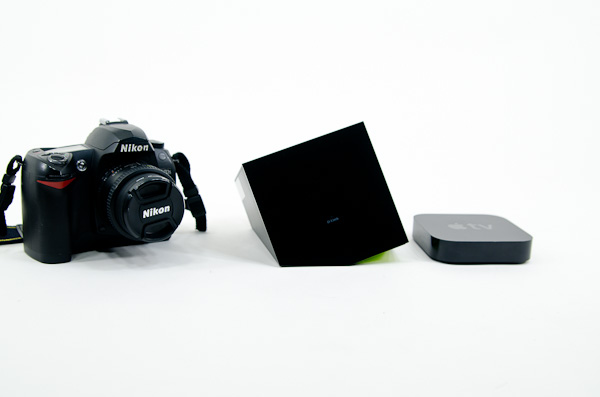
From left to right: Nikon D70, Boxee Box, Apple TV
Internally the Boxee Box is driven by an Intel CE4100 SoC and paired with 1GB of DDR3 memory.
The entire system is cooled by a single fan. The fan isn't loud but it is noticeable in an otherwise silent room thanks to its groaning sound. I couldn't hear it over any of the content I was watching however, even during quiet moments.
The Boxee Box is pretty easy to take apart, you just need a long Phillips head screwdriver with a small bit. Peel off the bright green rubber on the bottom to reveal the first six screws you'll need to remove.
Once inside there are a dozen or so other screws you'll need to remove to gain access to the motherboard (the gallery above shows you most of the process). The power supply is external which keeps a lot of clutter out of the case itself. The heatsink uses a thermal pad to make contact with the SoC making removing/replacing it a breeze:
The motherboard itself is tiny, much smaller than a mini-ITX board. I'm sure a lot of folks would be very pleased if Intel or someone else made a reference design like this that you could just buy on your own:
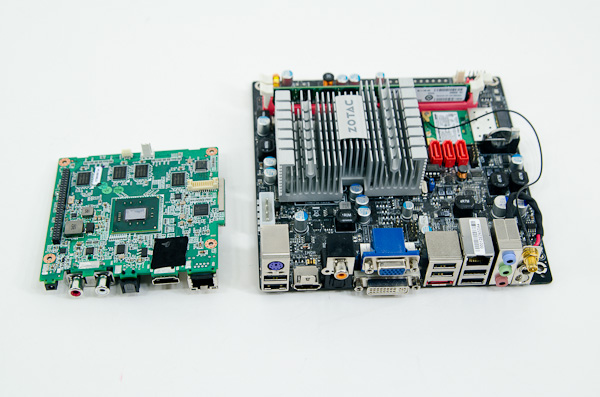
Boxee Box CE4100 motherboard (left) vs. Zotac ION mini-ITX motherboard (right)
See that little black tape covering a piece of the Boxee motherboard? Lift it up and you'll see a pretty significant rework on the board:
See the resistor mated over R12 (about half an inch from the top of the board in the above picture)? That's a rework. An error in the original PCB layout that had to be corrected after the fact. There's actually another one about half an inch lower. These two reworks appear to be on all Boxee motherboards. The black tape is used to keep them from being knocked loose. Future revs of the board will likely correct this problem and avoid the rework entirely. It's not a problem at all and won't impact reliability, just interesting to see on a final retail product.
The CE4100 die measures approximately 8mm x 12mm, putting its total die area at 96mm2. That's roughly 3.6x the size of the Pineview Atom in current netbooks, but still a pretty small die. By manufacturing it at 45nm the CE4100 is cheap to make as it doesn't require any capacity from Intel's latest 32nm fabs.
Intel’s CE4100 SoC
Intel first started down the path to Smart TV two years ago at IDF alongside Yahoo. The goal was to enable internet connected TVs equipped with Intel CE3100 SoCs running Yahoo powered widgets. You’d get your normal TV viewing experience but you’d be able to pull in content from the web. That partnership didn’t really go anywhere, so when Intel introduced the successor to the CE3100, aptly named the CE4100, Yahoo was nowhere to be found.
The CE4100 announcement happened a year after the CE3100 and Intel was light on partner details at the time. Several months later, Google started talking about Google TV and we knew where the CE4100 would eventually find its home.
Today the CE4100 is used in a decent number of devices, but not that many when you consider how many netbooks, notebooks and desktop PCs use Intel’s x86 silicon. The Boxee Box and all Google TV products (Logitech Revue, Sony’s Google TV box and the four Sony TVs with integrated Google TV) all run some variant of the CE4100. Intel is expecting two more CE4100 based products to ship in Europe in the near future and over the next 12 months we’ll see even more product launches.
Intel’s goal in this space is to put out a new chip every 12 months. The CE4200, announced at this year’s IDF, is the next member of the family and we’ll probably see a CE5100 at IDF 2011.
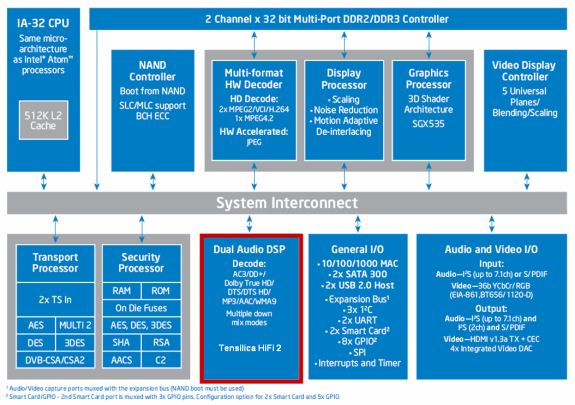
At a high level the CE4100 used in the Boxee Box pairs a 45nm Atom core (architecturally identical to what’s in Moorestown and Atom based netbooks/nettops) with a bunch of CE specific IP blocks.
There’s a dual stream 1080p video decoder that can offload H.264, MPEG-2, MPEG-4/DivX and VC-1 decoding at up to 60 fps (hardware accelerated JPEG decoding is also supported). Intel integrates a Tensilica HiFi 2 DSP that can decode everything you’d want to on a set-top box: Dolby Digital 5.1, TrueHD, DTS-HD MA, MP3, AAC and WMA9.
As some Boxee users have discovered, MJPEG isn’t supported by the video decode block. Since Atom is a general purpose x86 processor Boxee/D-Link do have the ability to decode MJPEG (or any other codecs) in software, assuming the CPU core is fast enough to handle the task.
All the I/O you need is also supported by the CE4100. There’s an integrated NAND controller for on-board solid state storage, 10/100/1000 ethernet support, 2 x 3Gbps SATA ports and 2 USB 2.0 ports. For audio and video you’ve got HDMI, SPDIF and RCA audio outputs.
Intel has an on-die security processor that handles all of the DRM and conditional access necessary to enable popular multichannel lossless audio codecs and decode protected video content.
The CE4100 GPU is the same PowerVR SGX 535 used in the MID/smartphone implementations of Atom. It runs at up to 400MHz depending on the particular CE4100 model you’re looking at.
Feeding all of the blocks on the CE4100 are two 32-bit DDR2/DDR3 memory controllers. This is 2x the memory bus width of the Atom Z600 series targeted at smartphones and made necessary due to the bandwidth demands of decoding high bitrate 1080p video.
As I mentioned above the CPU core is identical to all other 45nm Atom processors. It has a 512KB L2 cache and a 24/32KB L1 cache (I/D). The chip runs at either 1.2GHz or 1.6GHz depending on the particular SKU. Although we’ve been calling it the CE4100, there are actually four SKUs that presently make up the CE4100 family. Their names and specs are below:
| Intel CE4100 Family | ||||||
| SKU | CPU Clock | GPU Clock | A/V Capture | TDP | ||
| Intel CE4110 | 1.2GHz | 200MHz | No | < 10W | ||
| Intel CE4130 | 1.2GHz | 200MHz | Yes | < 10W | ||
| Intel CE4150 | 1.2GHz | 400MHz | Yes | < 10W | ||
| Intel CE4170 | 1.6GHz | 400MHz | Yes | > 10W | ||
It’s unclear what SKUs are used in the Boxee Box and Google TV platforms. Boxee told us there’s a 1.2GHz part inside the Box, so if I had to guess I’d peg it as the CE4110 to keep costs down.
Hyper Threading is supported by the underlying architecture but it is not enabled on the first generation of CE4100 SoCs. Next year Intel will ship a new member of the CE4100 family with HT enabled.
The CE4100 doesn’t support a number of power management features today. The platform doesn’t support Suspend to RAM (STR), which I noticed in my Boxee testing. There’s no difference in power consumption between an idle Boxee Box and one that’s put to sleep - both consume 11 - 13W of power because STR doesn’t work.
Intel plans on enabling STR next year however it’s unclear whether Boxee will be able to backport STR support with a software update or if it’ll need a hardware modification as well. If the latter is true, current Boxee users will likely be out of luck.
There’s also no clock or power gating supported on the CE4100, which manifests as higher than expected idle power consumption on the Boxee Box. The lowest I saw was 11.2W when the box was totally idle, which isn’t bad compared to a HTPC but is much worse than your typical streamer boxes. I would expect roughly half that. Without power gating all of the blocks you see in the diagram above are always using power, even when they’re not in use. They may not consume as much power as they would while active, but they are still senselessly snacking on watts.
The CE4200, announced at this year’s IDF, adds a few features onto the CE4100 that should make the next version of the Boxee Box even better should Boxee/D-Link choose to use it.
The CE4200 adds power and clock gating, which will drive idle power consumption lower. Presumably STR will also be supported in the first releases of the 4200. The CE4200 includes a CableCARD interface and a hardware video encoder that could enable some interesting usage models. Imagine a Boxee Box like device with an iPhone dock that would automatically transcode and let you take your content with you.
I asked Intel if it ever plans to offer reference designs to the general public based on the CE4100 or CE4200. While there are licensing issues involved in offering the shipping CE4100 to the general public (e.g. you need to be a DTS license holder), Intel did mention that it may begin offering reference platforms to interested customers/distributors once the Google TV source code is published next summer.
The Boxee Remote
You have two options for controlling the Boxee Box. You can use the Boxee iPhone Remote app (free) or the bundled Boxee remote.
It’s surprising that Boxee/D-Link were the first to build a remote like this. You have a simple remote control on one side, and a full QWERTY keyboard on the other. Pure genius. As a result the remote is pretty large - taller than your average smartphone, but incredibly versatile.
The actual remote side has three buttons and a directional pad. The topmost button is a play/pause button, that is only useful for playing or pausing content. The bottom button is a menu button which doubles as a back button depending on context. The directional pad is used for menu navigation, as well as volume output on the box. With your TV already on, you can effectively control everything you need to via the Boxee remote alone as a result. In the center of the dpad is a third button used to select menu items (and also to bring up a playback menu in certain situations). The multiple roles the buttons have to play can be frustrating for new users because there’s often little consistency. Try adjusting volume up/down before you take a web video full screen and you’ll get an error telling you that the video you’re watching doesn’t support the skip ahead function. Then there’s the Pandora app which uses up/down on the dpad for menu navigation and there are a separate set of -/+ controls for adjusting the volume.
Because of the simple front, the remote is easy to hold the wrong way. Whenever I grabbed the remote without looking I often found myself holding it upside down. Button feel is disappointing. All of the buttons feel very cheap and they’ve got this plasticky click to them.
The QWERTY keyboard is a wonderful addition to the remote as it makes all text entry a non-issue. You can fill text input fields you encounter with the remote’s keyboard. It’s much easier than hunting for letters via the onscreen keyboard, although you do have that option if you like torturing yourself. The remote’s keyboard is super convenient and avoids the silliness that we’ve seen with Sony’s Google TV remote/keyboard/Atari-Jaguar-controller-imitation.
The Boxee remote communicates with the box via RF and not IR, so you don’t have to point it at the box. Range is also good over RF, I measured about 50 feet through a wall and down a hall before the remote stopped responding.
Booting and Strange Sleep Habits
Booting the Boxee Box takes longer than expected. I measured 65.1 seconds from full power off to the home screen, including automatically logging in via WiFi. Waking up from sleep is awesome though, the system is up and running within 1.5 seconds of hitting the menu button on the remote.
The excitement quickly faded though when I realized that sleep mode on the Boxee Box doesn’t actually save any power. Remember the current version of the CE4100 reference platform doesn’t support Suspend to RAM. While asleep the Boxee Box still draws 11.2W at the wall, virtually identical to its power draw while idle but awake. No wonder it wakes up so quickly, the box is still fully powered while asleep.
You’re better off just setting the screensaver to blank the screen rather than putting the Boxee Box to sleep.
Home Simplified Home
The Boxee Box requires a Boxee login to work. Thankfully Boxee doesn’t require any personal information, just a user name, email address and password. You can sign up via www.boxee.tv or on the Boxee Box itself. I already had a Boxee login but I couldn’t remember my password, which presented me with the first problem: there’s no way to recover your password from the Boxee Box itself. You have to hit Boxee’s site with a Mac, PC, smartphone, iPad or something else with a web browser to tell it you’ve forgotten your password. With my password reset, I was back to the Box.
The setup process is pretty simple. You adjust overscan to fit the Boxee desktop on your TV and that’s pretty much it.
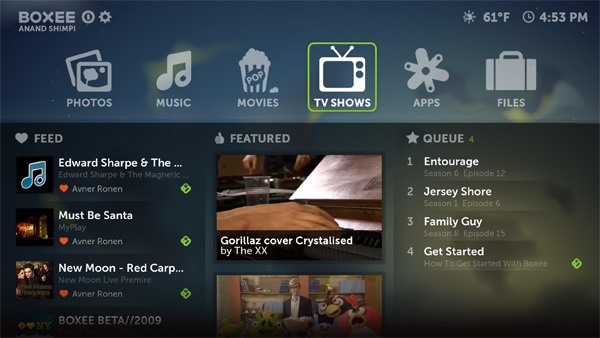
Boxee on the Mac
The Boxee Box interface isn’t quite as nice as it is on the current Mac/PC release of the software. It’s a bit simpler, a lot less crowded, but it feels older. Personal preferences aside, the interface is well laid out and functional at least.
The Home screen is, well, home to six major hubs: Friends, Watch Later, Shows, Movies, Apps and Files.
With the exception of Files, the hubs are designed to make Boxee more than just a dumb box that streams files off of the network. Remember this thing has an Atom based Intel CE4100 with more horsepower than you need for basic streaming.
Boxee views itself as a social device and as such there’s a focus on sharing content. You can follow other Boxee users and they can follow you. Shows you like will be added to your followers’ streams and vice versa. The Friends hub shows you the content your friends are currently liking/sharing/interested in.
The Watch Later queue is exactly what it sounds like. As you browse content (both on the web and on your own network) you can simply add it to the Watch Later list. It’s a useful way to reduce the sea of content available on Boxee down to stuff you can watch when you’ve got some free time.
The main event however is the next hub: Shows.
The Main Event: Shows
I canceled my digital cable subscription over a year ago. I never had time to watch shows when they aired, I always ended up DVRing them. By the time I got around to watching the shows I’d recorded, they were already available on the web and in some cases it was more convenient for me to watch them on my computer (I could watch while testing, for example). I’d get more entertainment out of holding public burnings of my $70 every month than paying Time Warner, so I canceled my digital cable package. The content I wanted to watch was on the web already by the time I was ready to watch it, I just needed a good way of aggregating it.
Netflix got me my fix for a lot of stuff. I don’t necessarily use it too much for movies (image quality isn’t high enough on a large projected screen) but for catching up on old TV shows it works well. The main benefit is instant streaming. It works on virtually every device I have hooked up to a TV and it works well.
The Netflix analog for newer TV, I’d guess, is Hulu. Unfortunately Hulu doesn’t work on every device I have hooked up to a TV and if you want to get Hulu on a non-PC device you pretty much have to sign up for Hulu Plus at $8 per month for roughly the same content I already get for free on the web. I’d rather strangle myself.
Could Boxee fill the void in my mindless content consumption? No, not completely at least.
Boxee approaches the problem with the best intentions. Select the Shows hub from the home screen and you’re immediately dropped into a clean listing of the 1000+ most popular TV shows available on the web. Each show is represented by a poster although you can switch to list view by toggling the icon in the upper right. It doesn’t matter where the shows are located, whether on the web or on your network, Boxee aggregates them all and presents them to you like a very cool TV guide channel.
Flip the remote over and begin typing the name of the show you’re looking for to bypass scrolling and begin searching. The search results take a couple of seconds to pop up. The Box isn’t as fast as a modern PC running Boxee’s software.
Like most hubs in Boxee the Shows view is simply for content consumption, you can’t configure the view or sort from here. If you bring up the dropdown menu you can choose to view TV shows by popularity, recently added, alphabetically, by genre or even by cable network.
Pick the show you want and the Boxee interface continues to impress. Instead of getting a haphazard listing of episodes the software organizes each available episode into seasons and then chronologically into episodes. Boxee presents a screengrab and synopsis of the episode as you scroll down the list. It’s honestly easier to use than the actual websites the episodes are pulled from.
Select an episode to play and you’re given options for where to play it from if there are multiple sources (e.g. Fancast and Comedy Central may both offer the same show, or you may have a copy of that episode on your network already). Boxee tells you whether or not the source is ad supported, although there’s little you can do about that other than prepare to watch the same ad three or four times while you watch your show. But hey, it’s still better than paying for cable.
As I just mentioned, Boxee doesn’t differentiate between locally stored and web content. You don’t actually know where the content is located until you actually try to play a show. For locally stored video, there’s grey text listed on the screen indicating the path/filename which is useful if you have multiple resolution copies of the same content.
Boxee views itself as a social video platform, so not only can you watch episodes from here but also share them with your friends. This is only useful if you have enabled Twitter/Facebook integration or you have other Boxee users who follow you as well. The latter I believe has the most potential as I’m not sure you want to bother all of your Facebook friends and Twitter followers with everything you like to watch on TV.
You can favorite a show so you won’t have to keep going through the full listing of most popular shows to find what you’re looking for. Favorite enough shows and it’s almost like you finally have your own al-a-carté cable package, for free.
Everything I described up to this point sounds great. Conceptually Boxee is exactly what I wanted. Aggregate TV content on the web and present it in a way that doesn’t make me feel like I’m actually using the web. Unfortunately there are two issues with the Boxee Box in this regard.
First is easily picked up by users of Boxee’s free software: you don’t get as much content:

Boxee Software
You’ll notice that the major networks aren’t covered. For example, while you can access CBS.com content via downloadable Boxee software, you can’t on the Boxee Box. I’m guessing this is due to Boxee’s deal to bring Hulu Plus to the platform in the future. This flies in the face of Boxee’s purpose however. Selectively aggregating free content and forcing you to pay for content that is freely available on the web sort of defeats the purpose of Boxee.
The second issue is what happens when you actually decide to start watching a show. With the free downloadable Boxee software you get a full screen window of the show you picked to watch. On the Boxee Box however, you get this:
That’s right. Playing (almost) any show on the web takes you to a WebKit based web browser that loads the web page that has the video you’re trying to watch. I’m guessing the default behavior of the Boxee Box is designed to avoid conflicts with content providers. The content owners get a hit on their webpage and the user is exposed to all advertisements.
The Boxee browser’s user agent is Mozilla/5.0 (Windows; U; Windows NT 6.1; en-US) AppleWebKit/533.9 (KHTML, like Gecko) Chrome/6.0.400.0 Safari/533.9, so most websites should just work with it.
Watching video in a small window on a web page on your TV isn’t exactly glamorous, so Boxee gives you the option of making the video full screen. Hit the menu button on the remote and select the full screen icon to make the video full screen. You don’t have to fiddle with anything within the webpage, just use Boxee’s own widget to enlarge the video. Note that this isn’t necessary on some content. I found that you could watch South Park episodes and have them appear in full screen by default, however anything else from Comedy Central requires you to use the fullscreen widget.
It gets worse. Anything provided by Fancast doesn’t work with Boxee’s fullscreen widget. Instead you need to position your mouse cursor over the embedded video player’s fullscreen button and select it. Thankfully Boxee tries to do this for you automatically when you load the video. You’ll see the mouse cursor snap to the location of the fullscreen button in the video player. Unfortunately it doesn’t always work. If the video is too tall the feature won’t work and sometimes the mouse cursor will snap to a position a couple of inches above the fullscreen button. It’s not always consistent, which is a problem if you share your TV with roommates, family members or guests who don’t know the intricacies of watching TV on a Boxee Box.
The fact that you even have to deal with this sucks, but it’s not the end of the world. And if the Boxee Box worked flawlessly at this point I’d have very little to complain about. It doesn’t.
Trouble at the Main Event
Loading shows is slow. It’s not unbearable, but definitely not instantaneous. As you’ll see in the YouTube video I’ve embedded below, it took me around 25 seconds to start playing content once I’d selected it. That’s not exactly quick. Doing the same on a modern PC would take about 14 seconds (including loading a webpage and hitting play on the embedded video player.
It’s not just performance though, there are clear bugs in the software. I tried watching Conan and once I took it full screen elements of the webpage behind the full screen window would appear as thin white lines on top of the video.
Sometimes I’d try to watch a show (not on Fancast) and the full screen option was missing. No matter how many times I backed out and reloaded the full screen option just wouldn’t be there. I’d have to reset the Boxee Box to get it back.
Watching an episode of The Jersey Shore (Boxee made me do it) I encountered a strange stuttering problem. The audio remained in sync while video just chopped away. Exiting full screen mode usually alleviated the problem but sometimes it didn’t.
Sometimes you’d get a video that would just stop animating for a few seconds. Audio keeps going but the video just stops completely only to pick up a few seconds later.
A few times I’d be watching a show and audio would drop out halfway through watching it. There’s absolutely nothing you can do when this happens, absolutely nothing. Most shows won’t remember where you left off and most don’t support fast forward properly so you have to leave the browser, re-enter (or sometimes reset the Boxee Box) and watch the entire show again to get back to where you were.
While the fast forward function doesn’t work in the vast majority of cases, you can do it in the old fashion way. First, back out of full screen view to the browser with embedded video. Using the dpad on the remote you can move a mouse cursor to the progress bar in the embedded video player and use the center button on the remote to pick a time that’s close to where you left off. It’s an absolute pain to do this but it technically works. And therein lies the problem. Boxee’s ease of use falls apart when you have to deal with loading web pages, manually going into full screen mode, backing out when audio stops working, dealing with artifacts on the screen and having to occasionally restart the box.
The Boxee Box does have a tendency to crash a lot depending on what you’re doing. A lot of the background indexing can sometimes hang the system and force a reboot of the entire machine without any warning (which you’ll see a few times in the video above).
Every layman I showed the Boxee Box was put off by its performance and finicky behavior, usually saying something like “this is really slow, don’t give it a good review”, “this is stupid why is it in a little window like that? don’t give it a good review” or “are you going to give this thing a good review?”.
It’s easy to use for me and I think if you know how it works it’s not hard to get around its quirks, but dealing with these issues isn’t intuitive. People are used to just turning on the TV, picking the channel they want and watching a show. Boxee changes the way you choose content (you pick the show rather than the channel) but the watching a show part is made more complicated in the process, and that isn’t acceptable.
I should add that not all of it is Boxee’s fault. Ultimately all Boxee does is interact with the underlying webpage that embed the video content. This does limit what Boxee can do (e.g. fast forward). However I haven’t encountered nearly as many issues with video on the web on my Macs and PCs as I did with the Boxee Box.
When it works, it is actually very nice. You get a lot of shows, not necessarily the most current stuff on cable TV, but you get it all for free. Boxee does a good job organizing it and presenting it in a clean manner. There’s potential here, but in its current state the Boxee Box needs work. The good news is that Boxee has been incredibly proactive and transparent in its handling of bugs, which is more than I can say for many larger companies that compete in the CE space. Chances are if you have a bug you can reach someone who cares at Boxee who will eventually get it fixed. It’s just a matter of whether or not you’re fine with paying $199 for something that needs a few software updates already.
About Hulu
Boxee and Hulu have inked some sort of a deal to bring Hulu Plus to the Box. That means at some point, for $7.99 per month, you’ll get access to Hulu Plus on Boxee. It’s cheaper than cable at least.
If you want to however, you can use Boxee’s browser to navigate to Hulu.com and watch videos for free. Boxee doesn’t make it easy to do since the web browser is very slow, but it is possible.
You have to navigate to Hulu.com using the Boxee browser and search for the show you want via a super tiny interface. Thankfully you get a nice overlay for entering in text fields on web pages, which helps move things along.
Other content owner websites worked as well, although with varying degrees of success. With NBC I had stuttering video playback at times and had a lot of problems trying to get an ad to go away while watching The Office. Watching House on Fox’s website was mostly flawless.
I hate to say it but Boxee could stand to have some sort of a mouse as an input. I’m guessing a trackpad is probably the easiest to integrate into the current remote design.
Movies
The Movies hub is identical to Shows but it contains movies from around the web. These are all legal sources of movies intermixed with stuff you have stored on your own network (more on how the network stuff works later). Unlike the Shows hub however, there just aren’t many relatively new feature length movies available for free on the web (legally).
Although the available movie selection isn’t nearly as current as TV shows, you do get more content. Currently the Boxee Box gives you movies from EZTakes, Indie Movies, MUBI, OpenFilm and YouTube Movies. Vudu is Boxee’s HD video rental partner of choice, however support isn’t enabled on the Boxee Box as of yet. You can rent via Vudu using the Boxee software on your Mac or PC though. With Vudu missing and Netflix coming, the majority of movies Boxee will find today are short indie films.
There’s room to grow on the movies side and if you find yourself watching independent films a lot online then Boxee might be a good fit for you today. For the mainstream however I don’t see the Movies hub getting much use until we get Netflix and Vudu support at least.
Networked Content
The Boxee Box has an integrated 10/100 ethernet controller as well as a Broadcom 802.11n WiFi controller. Either can be used to access web content, as well as content stored locally on your home network.
Up to this point I’ve mostly talked about what Boxee tries to do in terms of aggregating web content, but it’s similarly aggressive in finding stuff on your local network.
Through the Files hub you can tell Boxee to specifically look at and index certain file shares, but right off the bat Boxee displays everything that is publicly accessible on your network. This aspect of Boxee is very XBMC like. Just browse your network to where you keep your stash of TV shows and movies and you’re good to go. The interface is quick and logical.
Boxee really begins to shine however once you point it at a few locations on your network. I told it to index a shared RAID array in my main workstation, within minutes I had a nice library of local TV shows that I could watch. Based entirely on file names, Boxee goes out and fetches cover art, show and episode information for everything in my collection. I didn’t even have to lift a finger.
The same organization that Boxee uses on aggregated content from the web applies to content it finds on your network as well. That means under the Files hub I got a poster view of all of the TV shows I had on my computer.
We’ll get to how well it deals with various file formats in a moment, but the detection and organization Boxee offers is top notch. I don’t spend a ton of time organizing my content, I kind of throw it in the general area of where I want it to reside. Boxee cleans up after me, which is nice, it’s how technology should work.
You can add multiple network shares for Boxee to keep track of. Once added, Boxee will automatically try to categorize the content on your shares. Adding new content can be done automatically. By default Boxee scans all shares daily, although you can set that to once/never. The only downside to a daily scan is sometimes it appears to negatively impact stability, particularly if you don’t let a scan complete before putting the system to sleep.
There’s no option to scan even more frequently, which means you either have to force a scan if you want to watch something you just downloaded or you need to navigate to the content manually using Boxee’s file browser.
Boxee does require that you follow some basic rules when naming your files to enable its detection/categorization to work properly. TV shows should be labeled Show.Title.S##.E##.info.extension, Show.Title.#x##.info.extension while movies can be labeled Title.extension and Title.(YEAR).extension. Multipart movies are also supported, just add .cd# or .part# to the end of the file name. Coincidentally Boxee’s supported naming structure matches the way most pirated TV and movie content is distributed online. Fascinating.
We ran into some problems when playing back content stored over the network. On one occasion the Boxee Box refused to connect to any of our network shares, even though they were up, running and accessible from other systems. Restarting the Box fixed this problem.
There also appears to be a scheduling issue with the Boxee OS. Occasionally the file browser gets hung up on trying to grab a preview from whatever content you’re contemplating watching. If this happens you decide to back out using the menu button the entire system will freeze up. Progress indicators, remote, everything. At this point you can choose to pull the plug on the Box or wait several seconds for Boxee to sort itself out. It usually happens when you’re trying to play an odd file so thankfully it’s not something you’ll run into frequently, but it’s just a reminder that there’s still a pretty complex PC underneath the veil of simplicity.
The biggest problem of all is a rebuffering issue we saw with Blu-ray ISOs. The problem manifests exactly as it sounds. Go to play a Blu-ray ISO and you’ll get a few seconds of smooth playback followed by rebuffering for a couple seconds, then smooth playback again and rebuffering and the process continues over and over again. Boxee has already committed to fixing this problem in its next software update.
Attached Storage
You don’t need to have a giant network share to feed Boxee content. The Boxee Box has two USB ports and an SD/MMC card slot specifically for use with external storage. Once plugged in the external volumes appear in the Files hub and are treated like any other content source from that point on.
The Boxee Box had no problem reading from NTFS and FAT32 formatted external drives (HFS+ worked but I got an error before playback). They don’t have to be USB sticks either, I tried SATA to USB adapters attached to 2.5” SSDs without a problem. I also used a 16GB Patriot LX Series SD card with Boxee to play an episode of Mad Men without issue.
The Media Streaming Suite & File Compatibility
During the launch event for the Boxee Box in New York, Avner Ronen (CEO, Boxee) used our media streamer test suite on stage to demonstrate the extensive codec compatibility of the Boxee Box. After putting our review unit under the scanner, we realized that Boxee had indeed devoted efforts to ensure that they had the best compatibility score amongst media streamers. As the graph at the end of this section shows, the Boxee Box is bested only by HTPCs.
However, the high score in our media streamer test suite belies the fact that the Boxee Box had many issues with files it was supposed to play back without any problems. Before listing out the issues, let us look at the positive aspects:
1. High quality re-encoded non-DRM videos from non-streaming Internet sources play back without issues. Most commonly in the MKV or AVI format, with H264 / MPEG4 video and DTS / AC3 / AAC audio tracks, the Boxee Box is able to handle anything thrown at it in this department with aplomb.
2. Streams for which hardware acceleration is not supported (such as RMVB) are decoded on the host CPU (Atom)
3. MPEG-4 decoding has no problems with Q-Pel and Global Motion Compensation (GMC) with multiple warp points. This is one aspect with which streamers based on Sigma Designs and Realtek SoCs have problems.
Once we started testing out the common formats for personal backups (ISOs / M2TS), the issues started cropping up.
1. TrueHD audio is not bitstreamed to the AV receiver.
2. There are very minor stutter artifacts while decoding L5.1 1080p60 H264 clips
3. Stylized subtitles (ASS / SSA) are woefully bent out of shape and misplaced on the screen too. Karaoke subtitle effects are not rendered.
4. Video in WTV containers is not recognized (possibly due to lack of public knowledge about the structure of the container)
5. Bugs existing in ffmpeg are carried over to the Boxee Box. A couple of H.264 / AC3 M2TS clips for which the ffmpeg splitter doesn't work well (on HTPCs) have slight stuttering issues. Interestingly, none of the Realtek or Sigma Designs streamers (except for the WDTV lineup) have this problem. The WDTVs exhibit the same issue as the Boxee Box for these clips.
6. HD Theora videos playback audio only, as the video has too much resolution to be reliably decoded by the Atom host CPU without hardware acceleration. This issue applied to our 1080p RMVB file also.
7. MKV sample with H264 video and TrueHD audio, along with PGS subtitles, crashed the system completely after the streamer made an attempt to try to demux and decode all the applicable streams.
8. DTS-MA audio in MKVs have some audio dropout issues.
9. Some M2TS clips (both H.264 and MPEG-2 content) buffer a little, play a bit and go back to buffer some more, even though these clips are on a local USB drive connected to the unit. This process keeps on repeating causing stuttery playback.
10. Forced subtitles in MKVs are not handled properly. Subtitles being on by default is a major issue too, and that has ramifications in this scenario.
11. At least 1 MakeMKV created BR folder structure resets the Boxee Box back to the main screen.
12. The CE4100 SoC doesn't have MJPEG decode which is what many older cameras record video in.
The encouraging thing is that the Boxee developers have obtained samples from us for streams which are meant to be supported. We should hopefully see fixes soon.
With the firmware v 1.0.1.16125, the Boxee Box obtained a score of 286 out of a maximum possible 358. With a normalized score of 79.89%, it is comfortably ahead of streamers such as the WDTV Live Hub.
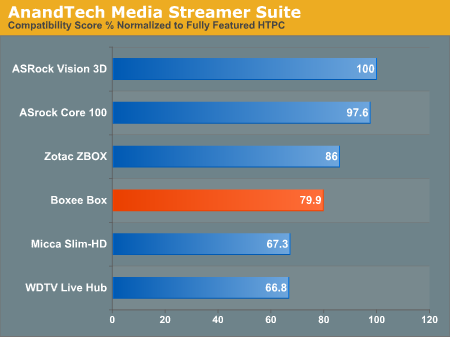
Think of the Boxee Box as a pre-configured HTPC. It almost reaches the compatibility levels of the Atom/ION ZBOX, perhaps losing out on some Windows specific formats. After codec compatibility, next up on the list is picture quality.
Video Decode Quality with HQV 2.0
One of the bugs in the currently available firmware for the Boxee Box is the constant buffering and stuttering of Blu-Ray M2TS files, even over USB. Unfortunately, the HQV 2.0 benchmark we have is a set of M2TS files from a Blu-Ray ISO. I had to put up with constant interruptions in the benchmarking videos, and as such I wasn't very comfortable tabulating the results. I tried repeating playback of each stream more than 3 times each to ensure that I had a fair idea of how the playback quality turned out.
| Boxee Box : HQV 2.0 Benchmark | ||||
| Test Class | Chapter | Tests | Max. Score | Boxee Box |
| Video Conversion | Video Resolution | Dial | 5 | 0 |
| Dial with Static Pattern | 5 | 5 | ||
| Gray Bars | 5 | 5 | ||
| Violin | 5 | 5 | ||
| Film Resolution | Stadium 2:2 | 5 | 0 | |
| Stadium 3:2 | 5 | 0 | ||
| Overlay On Film | Horizontal Text Scroll | 5 | 3 | |
| Vertical Text Scroll | 5 | 5 | ||
| Cadence Response Time | Transition to 3:2 Lock | 5 | 0 | |
| Transition to 2:2 Lock | 5 | 0 | ||
| Multi-Cadence | 2:2:2:4 24 FPS DVCam Video | 5 | 0 | |
| 2:3:3:2 24 FPS DVCam Video | 5 | 0 | ||
| 3:2:3:2:2 24 FPS Vari-Speed | 5 | 0 | ||
| 5:5 12 FPS Animation | 5 | 0 | ||
| 6:4 12 FPS Animation | 5 | 0 | ||
| 8:7 8 FPS Animation | 5 | 0 | ||
| Color Upsampling Errors | Interlace Chroma Problem (ICP) | 5 | 2 | |
| Chroma Upsampling Error (CUE) | 5 | 2 | ||
| Noise and Artifact Reduction | Random Noise | SailBoat | 5 | 0 |
| Flower | 5 | 0 | ||
| Sunrise | 5 | 0 | ||
| Harbour Night | 5 | 0 | ||
| Compression Artifacts | Scrolling Text | 5 | 3 | |
| Roller Coaster | 5 | 3 | ||
| Ferris Wheel | 5 | 3 | ||
| Bridge Traffic | 5 | 3 | ||
| Upscaled Compression Artifacts | Text Pattern | 5 | 3 | |
| Roller Coaster | 5 | 3 | ||
| Ferris Wheel | 5 | 3 | ||
| Bridge Traffic | 5 | 3 | ||
| Image Scaling and Enhancements | Scaling and Filtering | Luminance Frequency Bands | 5 | 2 |
| Chrominance Frequency Bands | 5 | 5 | ||
| Vanishing Text | 5 | 5 | ||
| Resolution Enhancement | Brook, Mountain, Flower, Hair, Wood | 15 | 10 | |
| Video Conversion | Contrast Enhancement | Theme Park | 5 | 0 |
| Driftwood | 5 | 0 | ||
| Beach at Dusk | 5 | 0 | ||
| White and Black Cats | 5 | 0 | ||
| Skin Tone Correction | Skin Tones | 10 | 0 | |
| Total Score | 210 | 73 | ||
The Boxee Box appears to fare a little bit better than the average WDTV type streamer even with the unreliable firmware. Do note that some of the tests simply make no sense for the Boxee Box because the knobs to activate and test out the features just don't exist (as Boxee probably doesn't want to befuddle the average user with some arcane menu options).
That said, one of the disappointing aspects revealed in the above benchmark is the complete lack of cadence detection. Hopefully, the end user doesn't want to spend too much time watching interlaced videos at non-native video refresh rates. Other than that, we wouldn't fault Boxee too much for not scoring higher in this benchmark.
Music & Photos
Boxee’s Files hub also enables music and photo streaming from networked and attached storage.
The Box does a great job finding music and displaying album art, but that’s pretty much the extent of what Boxee can do with your MP3s. There’s no quick way to search for songs and no playlist support from what I can tell. You can just view your music collection by album or by artist.
The photos browser includes all folders with any photos in them, so you need to be careful to keep your photos segregated from things like apps. Despite Boxee’s intelligence, it does help to create individual shares based on the type of content you have (e.g. a share for pictures, a share for music, a share for movies, etc...).
Although RAW files appear in the file browser, I couldn’t get the Boxee Box to load any .NEF files taken with my Nikon D700. Performance is also a problem. Some thumbnails appear quickly while others can take a very long time to show up.
By default there’s a ridiculous amount of Ken Burns effect applied to any slideshow (you can disable it in the settings menu), and viewing photos in any directory becomes a slideshow by default. The play/pause button on the remote comes in handy.
You zoom and rotate photos using onscreen controls. The zoom function desperately needs some sort of multitouch interface, while rotate is pretty quick.
The integrated SD/MMC card reader is a great way to display photos on your TV. It’s a nice addition to the Box.
Apps
Like almost everything these days, the Boxee Box supports apps. For the most part these aren’t apps like you’d find on your smartphone, but rather collections of video content from the web. A surprising number of companies/websites have Boxee apps. There’s YouTube Leanback, revision3, TED, Flickr, Wired, cnet TV, Fail Blog, and Reddit TV among others.
You can favorite apps as well so you don’t have to scroll through the list of 100+ Boxee apps to find what you’re looking for. The apps hub is also how you get get direct access to the Boxee Browser.
There’s tons of really good free video content online and Boxee apps are a great way to get access to it. I was actually surprised by how big the Boxee app ecosystem already was.
Turn off adult mode in the settings menu and you’ll even get some porn apps, just in case you wanted a quick way to get your favorite internet porn onto your TV.
Boxee does support background operation of apps. The Pandora app keeps running (and playing music) even after you back out of the app. The Boxee menu gains a play/pause button and tell you the name of the track you’re currently listening to. Selecting the Pandora widget brings up more playback controls and a visualization. As soon as you start playing any content that has audio however Pandora pauses automatically.
The Pandora app itself is just like what you get by visiting the webpage. You give it your login information and you get full access to all of your stations. You can like/dislike songs, skip forward and even create new stations.
Settings
Since Boxee started from within the enthusiast community, it is one of the more configurable commercial media streamers available today. To access Boxee settings you have to select the gear widget from the menu dropdown in the upper left corner.
Boxee Box settings are divided into seven categories: General, Social, Media, System, Network, File Sources and Adult. What you can do within each is listed below.
General
The general settings page had options for setting the current time and location. Boxee will give you a little icon telling you today’s weather based on your location. This is where you set display options as well. The Boxee Box can output 480p, 720p, 1080i and 1080p. Common to both Boxee and XBMC is the ability to match screen refresh rate to the refresh rate of your video, which you can toggle here as well.
Users with cinemascope projector setups will rejoice as Boxee supports 2.35:1 aspect ratios as well as 4:3, 16:9 and 16:10.
If you need to tweak overscan you can do that here as well. There are two routes of adjusting overscan, either manually stretching a reference image until it fills the screen or by percentage (3 - 6%). On my 42-inch Westinghouse 1080p display the 6% setting worked perfectly.
Boxee also ships a handful of test patterns as well as the ability to check for dead/stuck pixels on your display by displaying solid color patterns on your screen (red, green, blue, white and black).
General settings include screen and power saver options, both of which can be set for a configurable period of time. You can even choose to have Boxee throw up a black screen or just dim the screen when idle.
Boxee offers a healthy list of language and character set options:
And finally you can choose to turn navigation sounds on/off (although you can’t replace them with your own), as well as choose to display hidden files/folders (disabled by default).
Social
The Social settings page only tells you that you can display videos from buzz, Facebook and Twitter streams. You can’t actually enable any of those here, you have to visit boxee.tv to do that.
Media
Here you can set the size, style, color and character set of subtitle text. You can disable the Ken Burns effect for photos in a slideshow as well as change the transition time and image display time.
There isn’t much customization for music playback, just enable/disable automatic playback of the next song in a folder.
A nice feature Boxee includes is to not resolve videos under a configurable size. It prevents Boxee from indexing videos that are clearly smaller than a full length movie or episode of a TV show (e.g. that video your mom sent you of a cat licking another cat).
System
One of the coolest settings Boxee enables is the ability to display a debug information overlay on your screen. You can control the level of detail you get (e.g. only displaying fatal errors) but you do get the option to display information like CPU utilization, memory usage and current frame rate. This is awesome. All platforms should allow this level of detail as an option.
Also from the system settings screen you can select what forms of audio output your receiver supports and choose between HDMI, optical and stereo outputs for sound.
Networking
Boxee offers all necessary networking options and a few that are specific to the Box. Here you can enable/disable the integrated webserver, which is used for the iPhone remote. You can also enable windows file sharing on the Box which gives you network access to the ~300MB of free space on the device.
Boxee also serves a webpage (http://boxeeip:8080) that contains error logs useful in debugging those oh-so-annoying crashes I mentioned earlier. The webpage also tells you how hot the CE4100 SoC is and how quickly the fan is spinning (which appears to always be set to a near-silent 50%).
File Sources
The File Sources settings lets you add/remove local and network shares that Boxee is monitoring for content. From here you can also change the frequency of scanning for any source.
Adult Content
Unlike Cable TV, you don’t exactly have to pay extra for adult content on the web and thus Boxee offers the ability to enable viewing of adult themed feeds and apps on the Box. By default it’s disabled and you do have the ability to set a password lock on the option if you don’t want just anyone to pop into the settings menus and enable it.
Power and Performance
The Boxee Box is made out of relatively low power hardware and as a result, total system power consumption never exceeds 15.2W. While playing Flash video content via the web I measured a consistent 15W power draw at the wall and the highest I ever saw it hit was 15.2W.
The lowest I ever saw the Boxee Box drop down to was 11.2W. Typically the Box likes to hang out around 13W, but I would expect much lower idle power from the CE4100 when absolutely nothing is going on.
The biggest problem is sleep power. If you put the Boxee Box to sleep it will draw anywhere from 11 - 13W, while asleep. There’s no difference between it being asleep and idle. This is a CE4100 limitation as I’ve mentioned before, so if you want to truly save power you’ll have to shut the Boxee Box down completely.
Performance, as I’ve mentioned before, is a problem with the Box. While menu navigation is quick (not PC-quick but quick enough), everything else could use some work.
Adding shows to your Watch Later queue is slow, loading YouTube Leanback is slow, searching for shows is slow. Once you start typing there’s a couple of seconds before you actually get results to pop up. Even bringing up the Shows hub and waiting for images to load takes time. And don’t get me started on browsing the web on Boxee. It’s just not fast.
Part of the problem is that we’re running on an 1.2GHz Atom, however even that should be enough for all of Boxee’s needs. Netbooks feel faster than this, which points the finger squarely at Boxee. The software is in dire need of performance optimization. Thankfully the UI frame rate never drops below 38 fps so it always feels quick, the problem is more the speed at which things load (particularly over WiFi).
Final Words
We’re on the cusp of the internet TV revolution. Networks are putting the majority of their content online in an ad supported form. If you just don’t mind visiting sites like Hulu and Comedy Central you really can get by without paying for cable TV these days. What we’re missing is a simple way to view all of the content on your TV.
Boxee is tackling an admittedly very difficult problem. Make it too easy and the content owners will crack down on you. Make it too difficult, and you end up with a platform that’s unsellable. At a high level, I believe Boxee has come very close to the perfect balance between the two extremes.
Content aggregation and organization is done very well. You don’t have to worry about where the shows come from, just pick what you want to watch. Boxee does compromise on the display aspect which is disappointing (but understandable). I wish everything worked like South Park and you were always dropped into a full screen view of the video.
My complaints on the web video side are mainly about performance and bugs. The box clearly needs work in the optimization and stability departments. In recording the demo video for this review I encountered three system-resetting crashes, not to mention countless others over the past week+ of testing. I don’t believe these are hardware issues, just the type of software bugs you encounter when dealing with a project of this complexity. At least Boxee has the excuse that it isn’t a multibillion dollar company (which is more than I can say for most others who ship buggy hardware). At $99 I'd live with the bugs until they got fixed. At $149 it's debatable. But parting with $199 for a product with bugs, even knowing they'll get fixed, is a tough sell.
As a network/local streaming box, Boxee is easily an entry level HTPC. You get the sort of features from a higher end HTPC, without having to deal with any of the software configuration on your own. The Boxee interface is sensible and quick to navigate.
You can’t build a similarly capable HTPC with better power characteristics than the Boxee Box (simply because Intel won’t sell you a CE4100).
The biggest drawback to the Boxee Box as a HTPC ultimately comes down to bugs once again. Boxee is at least responsive to the bugs that have been reported thus far, but that doesn’t change the fact that you’re buying into a platform that needs work.
I’d also like to see improvements in the auxiliary features. The photos browser needs a performance improvement and I’d like to see the web browser’s performance improved to the point where it could be a real alternative to Google TV. Doing the latter would require a reworked remote however as you’d need a better way to move the mouse cursor.
The list below summarizes much of what we’ve said in this review:
Pros:
1. Great UI & simple setup
2. Convenient remote control, small hardware
3. Can easily replace a entry level HTPC with respect to local media streaming features
4. Things can only get better
5. Proactiveness in bug fixing by Boxee. Engineers are on the lookout in various forums (not only Boxee's but also AVSForum). A bug regarding AAC multichannel decode was immediately acknowledged and a quick fix was committed for availability in the next release
6. $199 is cheaper than Google TV
Cons:
1. Green firmware at launch - multiple stability/compatibility issues and many bugs
2. Non-availability of premium content partners at launch
3. Standby power of 10W is laughable
4. Priced too high compared to other media streamers
5. Boxee is reliant too much on the file extension to determine the container, while other streamers tend to look at the header for this purpose
6. Inferior web browsing experience to Google TV
Luckily for Boxee, some points in the cons list can be fixed with firmware updates. Unless Boxee improves the firmware and fully supports formats which can be hardware accelerated by the CE4100, we wouldn't recommend purchasing the unit. Meanwhile, various online services such as Netflix should also be enabled. We will take another short look at the unit before Christmas once the bug fixes are made. The positive thing for Boxee right now is that the CEO and developers are listening and responding to our feedback. We are hopeful of a better experience with the Boxee Box later this year. Potential buyers should just wait and watch till things settle down.

